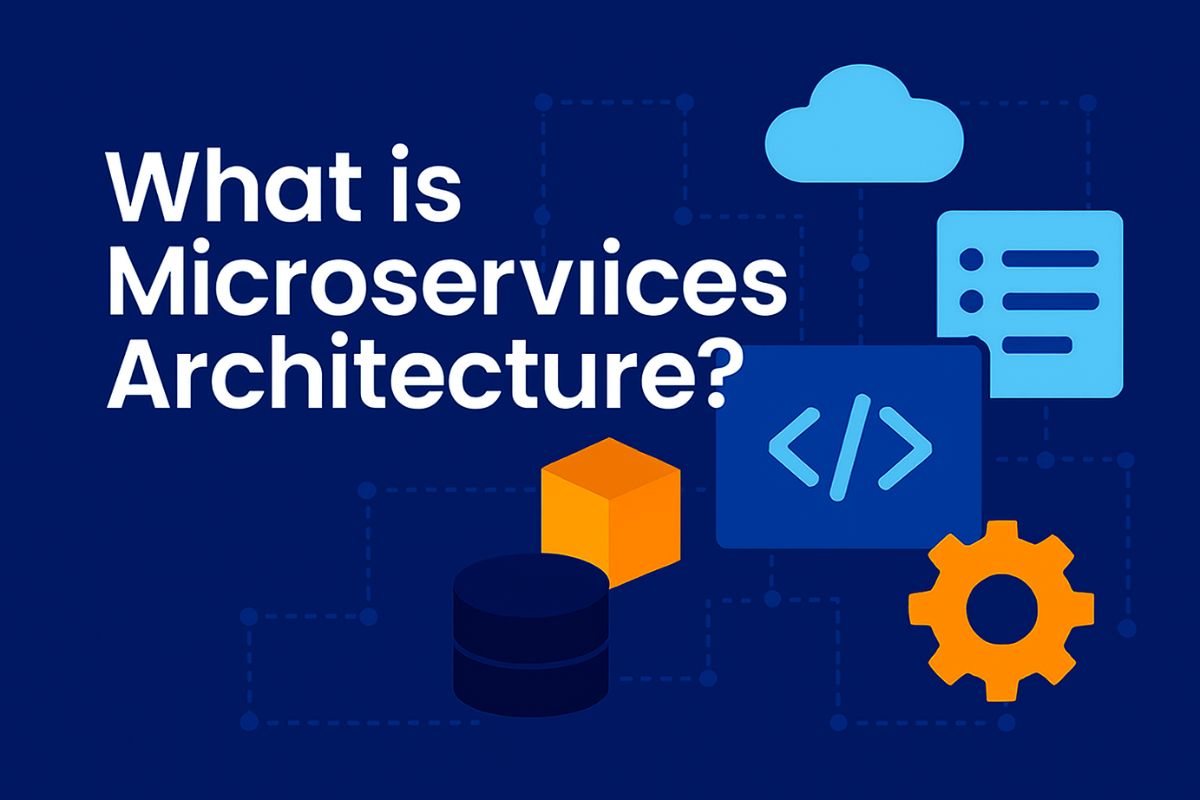Microservices architecture is a modern approach to software development where applications are structured as a collection of loosely coupled, independently deployable services. Each service focuses on a specific business function and communicates with others through APIs. This guide breaks down microservices in simple terms, explains how they work, explores their benefits, real-world use cases, and lists the tools and technologies essential for building and managing microservices-based systems.
In today’s fast-paced tech landscape, companies like Netflix, Amazon, and Uber need applications that can scale fast, deploy frequently, and remain resilient under pressure. That’s where Microservices Architecture comes in.
Microservices break down large, complex software into smaller, manageable pieces called “services,” each responsible for a specific functionality. Whether you’re a student, developer, or business owner, understanding microservices gives you insight into how modern apps are built and deployed.
This guide will explain microservices architecture in simple terms, explore how it works, and cover benefits, challenges, tools, and real-life examples.
What is Microservices Architecture?
Microservices Architecture is a software design style where an application is divided into small, independent services that run on their own and communicate over APIs.
Each microservice is:
- Focused on one task or function
- Independently deployable
- Developed and maintained by separate teams
Analogy: Think of a restaurant where each chef specializes in just one dish. The dishes are prepared separately but served together. That’s how microservices work — they specialize and then collaborate.
How Microservices Work
Each microservice typically:
- Runs in its own process
- Has its own database or storage
- Communicates via lightweight APIs (like REST or gRPC)
Microservices communicate through:
- REST APIs
- Message Queues (e.g., RabbitMQ, Kafka)
Services can be:
- Updated without affecting the whole system
- Scaled based on individual service demand
Microservices vs Monolithic Architecture
What is a Monolithic Application?
A Monolithic architecture is a traditional model where all parts of an application are built and deployed as a single unit. Everything — the frontend, backend, and database — is tightly connected.
Problems with monoliths:
- Hard to scale
- Difficult to update or fix bugs
- Deployment takes longer
Key Differences
| Feature | Monolithic Architecture | Microservices Architecture |
|---|---|---|
| Structure | Single unit | Independent modules |
| Deployment | Entire app at once | Each service independently |
| Scalability | Difficult | Easy and granular |
| Maintenance | Complex | Easier (service-specific) |
| Technology stack | One stack | Polyglot (different tech per service) |
| Failure impact | Whole app fails | Isolated to one service |
Real-World Examples of Microservices
Companies Using Microservices
- Netflix: Handles streaming, recommendations, billing, etc. via individual services
- Amazon: Search, cart, payments, inventory as separate services
- Uber: Navigation, notifications, bookings, billing all function independently
Common Apps Students Use
- Zomato/Swiggy: Orders, tracking, ratings, and payments are managed separately
- Paytm: Wallet, recharge, ticket booking handled by different services
Key Components of Microservices Architecture
1. Services
Small, independent units performing a specific business task
2. APIs (Application Programming Interfaces)
Facilitate communication between services
3. Service Registry
Keeps a record of all active services for discovery
4. Load Balancer
Distributes incoming traffic across multiple services
5. Independent Databases
Each service manages its own data storage
6. Monitoring & Logging Tools
Track service health, performance, and log errors (e.g., Prometheus, ELK Stack)
Benefits of Microservices
1. Scalability
You can scale individual services as needed, optimizing resources.
2. Faster Development
Teams can work on different services simultaneously.
3. Technology Flexibility
Different services can use different programming languages or databases.
4. Fault Isolation
Failure in one service doesn’t crash the entire app.
5. Easier Maintenance
Update, fix, or replace one service without touching others.
Use Cases of Microservices
- E-commerce platforms
- Streaming services (Netflix, Spotify)
- Banking apps
- Food delivery systems
- SaaS applications
- IoT platforms
Challenges of Microservices
1. Complex Communication
Increased traffic between services requires careful API management.
2. Deployment Management
Coordinating deployment pipelines for many services can be difficult.
3. Data Consistency
Managing transactions across multiple services is complex.
4. Debugging and Tracing
Harder to find the source of errors across services
5. Monitoring Overhead
Requires centralized monitoring and alert systems
Tools and Technologies for Microservices
Containerization & Orchestration
- Docker: Package services into containers
- Kubernetes: Deploy and manage containerized services
Communication
- REST / gRPC: APIs
- Kafka, RabbitMQ: Messaging queues
API Management
- Kong, NGINX, AWS API Gateway
Monitoring & Observability
- Prometheus, Grafana
- ELK Stack: Elasticsearch, Logstash, Kibana
CI/CD & Automation
- Jenkins, GitHub Actions, ArgoCD
Expert Tips and Learning Resources
Tips for Beginners
- Start with converting a simple monolith into microservices
- Learn Docker and API basics
- Understand REST and use Postman to test
Learning Resources
- YouTube Channels: Academind, TechWorld with Nana
- Courses: Coursera, Udemy
- Documentation: microservices.io, Kubernetes.io
Conclusion
Microservices architecture is the future of scalable, efficient, and agile software development. Whether you’re a student, beginner developer, or IT professional, learning how microservices work will give you an edge in modern application development.
Start small, pick one tool like Docker or Postman, and gradually move into building your own services. Microservices are not just for big tech — they are shaping the way apps are built worldwide.
FAQs
1. What is Microservices Architecture in simple words? It is a method of designing software where the app is divided into small services, each doing one job.
2. How is microservices different from monolithic architecture? Microservices have independent services, while monolithic apps are built as one single unit.
3. What are the advantages of microservices? They offer scalability, fault isolation, faster development, and easier maintenance.
4. What tools are used in microservices? Docker, Kubernetes, Kafka, REST APIs, Jenkins, Prometheus, etc.
5. Can beginners learn microservices? Yes! Start with small projects, learn APIs, Docker, and build experience step by step.
6. Why do companies prefer microservices today? They allow faster releases, resilience, and scaling for millions of users easily.
7. Are microservices only used in big tech? No. Even startups and student projects use microservices for flexibility.



